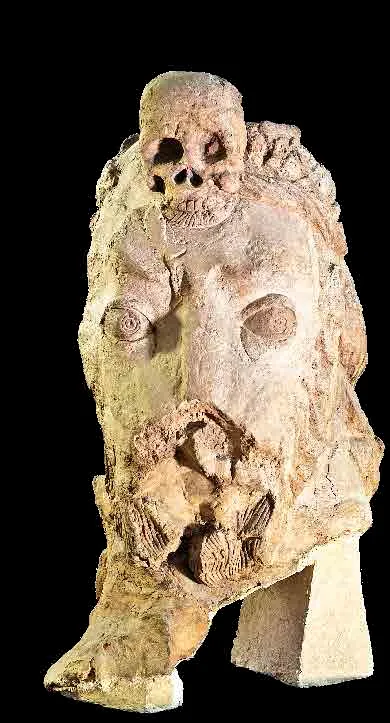
The Quvan sculpture was made of layers of clay with straw laid on the base of wooden blocks and reeds. A layer of plastic clay, 1.5 – 2 cm thick, was applied to the dried preform, which served to work out all the small details and create the final image. Details were also used that were moulded or stamped in clay separately and then mounted on the statue (curls, ornaments, flowers and leaves).
The sculptural findings from Quva are distributed between the State Museum of Arts and the State Museum of History of Uzbekistan. The exposition of the Museum of Arts currently features two statues: a three-eyed character found on a platform in the “temple”, and a character in a bandage crowned with a skull that was once placed on the facade. The interpretation of these and a number of other images has changed over time. So if the three-eyed character was considered by V. A. Bulatova as an image of the Buddha-Maitreya, then the scholar from Germany M. Mode believes that it is the head of the Sogdian pantheon Adbag (=Ahura Mazda=Indra); and for the specialist in Buddhist art T. K. Mkrtychev it is Makheshvara (“Great God”), which embodied the iconography of one of the main Hindu deities, Shiva.
The second Quvan sculpture from the exposition, with a skull on the headband, is assumed by V. A. Bulatova to embody the features of one of the so-called Lokapāla – guardiandeities of the four cardinal directions, whose iconography was characterized by fearsome features, because their task was to scare off evil forces hostile to Buddhism. Researchers have noted that, while technologically corresponding to the synchronous Buddhist sculpture of Tokharistan (the name of Bactria, known at least since the 2nd century AD) and the Zhetysu (Semirechye), the Quvan considerably differs from it in iconography.
According to analogies of iconography of a number of characters in the Quvan sculpture (appearance, colour solution, attributes), T. K. Mkrtychev suggested that the Quvan temple, with such a unique decor, belonged to one branch of Mahayana Buddhism that arose in the middle of the 1st millennium AD and was called “Vajrayana”. The formation of Vajrayana Buddhism was strongly influenced by one of the main branches of Hinduism – Shaivism, which can be seen in iconography. It is important to note that in Central Asia there are no traces of Vajrayana anywhere except for Quva. But in East Turkestan, namely in Hotan, it was widely spread, and this gave T. K. Mkrtychev a reason to assume that the construction of this temple in Quva could have been caused by close ties with Hotan, and that its decoration was performed by Hotan sculptors.
You can learn more about this topic in the book-album “The Collection of the State Museum of Arts of Uzbekistan” (Volume XIII) from the series “Cultural legacy of Uzbekistan in the world collections”.
The general sponsor of the project is the oilfield services company Eriell-Group.
